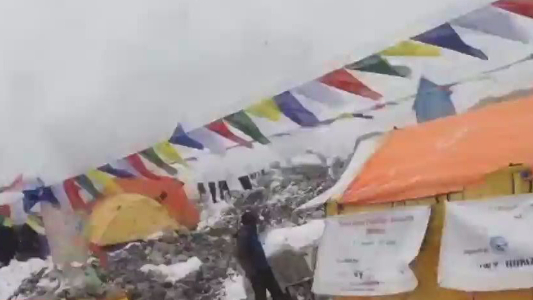A mammoth wave of snow darkens the sky over Everest Base Camp. Appearing like a white mushroom cloud roaring over the climbers, they scurry as their tents flap like feathers in the wind. Then panic hits.
“Whoa! Whoa!” Screams and expletives are heard.
The few people in the video scatter and dive into a tent as the deluge of snow falls over them. Cursing and breathing heavily, they wait until the pounding is over.
After a while, they scream to each other, “Are you all right?”
“Are you OK?”
The camera jostles back and forth as German climber Jost Kobusch heaves to catch his breath.
When they finally emerge from their avalanche ordeal, their faces are scarlet and their bodies crusted in snow. They trudge away, completely dazed and shocked.
“The ground was shaking from the earthquake and as soon as we saw people running, we were running ourselves to save our lives,” Kobusch wrote in a post on his YouTube video.
The harrowing two-minute clip shows the unimaginable scale of the avalanche that smashed into Everest Base Camp on Saturday. At least 17 people have been killed, with dozens injured and several missing — likely buried beneath the snow and ice.
The fates of the climbers and the local hires are one part of the enormous human toll in Nepal from the catastrophic quake that has so far claimed the lives of more than 4,300 people. At least 8,000 people were reported to have suffered injuries.
Helicopter rescues in the mountains
Helicopters brought stranded climbers off the mountain Monday amid growing concern for the groups stuck around 20,000 feet (6,100 meters) high in Camps 1 and 2. The climbers who were higher up Everest appeared to have avoided the deadly avalanche that struck Base Camp, but many — estimated to be in the hundreds — could not descend on their own.
The climbers can’t head down because the dangerous Khumbu Icefall has been ravaged by a series of aftershocks. The aftershocks sent snow and rocks thundering down the mountainside, complicating rescue efforts.
Tshering Sherpa, who manages the icefall route, estimated that 100 to 200 people were stuck in the higher camps after the avalanche.
“Bottom line, the icefall has been deemed impassable at this point,” said Alan Arnette, a climber and Everest blogger who was at Camp 2 when the avalanche struck. He said that climbers at Camp 2 and others higher up would descend to Camp 1 (elevation 19,500 feet) to await helicopters.
Arnette was helicoptered down to Base Camp on Monday.
Witnesses said three helicopters rescued climbers and Sherpas from Camp 1, taking two people down at a time.
Carsten Pedersen, a Danish climber at Base Camp, said that he heard a steady stream of helicopters ferrying people from the mountains back to Base Camp throughout the morning.
“They land every 10 minutes here,” Pedersen said. “I estimate half the people have been rescued, and it’s probably less than 200 people in the mountain this morning. I wouldn’t be surprised if 100 people came down already.”
The window for helicopter rescue was expected to be between 9 a.m. and noon Monday. The helicopter rescues are heavily contingent on the weather.
Jim Davidson, a climber on Everest, tweeted that the evacuations were going well.
Down at Base Camp, Jamlins Sherpa said he counted about 22 body bags that were to be transported back to their families in Kathmandu. The death toll on Everest is still unclear.
‘Massive loss of life’
In an audio blog recorded from Camp 2, Arnette signed off with this message: “It’s important, it’s not about mountaineering. This is about the earth and it’s a horrible loss of life at Everest Base Camp and down at Kathmandu.
“It’s a massive loss of life.”
A member of Arnette’s team, Eve Girawong, a medic from New Jersey who worked on the mountain, was killed at Base Camp, according to her family and employer.
Several Everest climbing teams have confirmed deaths. Five Nepali staff members were killed at Everest Base Camp and Camp 1, according to Adventure Consultants. It did not identify the staffers.
Three Sherpas from the 360 Expeditions team died, the company posted on its Facebook page. Their names were also not revealed.
The foreign casualties at Everest Base Camp include Dan Fredinburg, an American executive at Google who died after suffering a major head injury, and Tom Taplin, a documentary filmmaker from California.
“He was blown away by the blast rather than being buried in any rubble,” Taplin’s wife, Corey Freyer, told CNN affiliate KABC.
The exact number of dead remains unclear.
